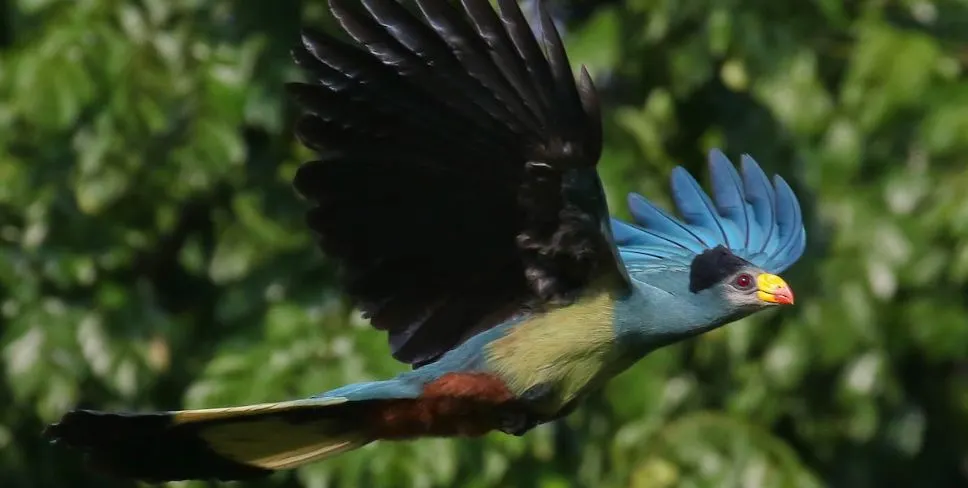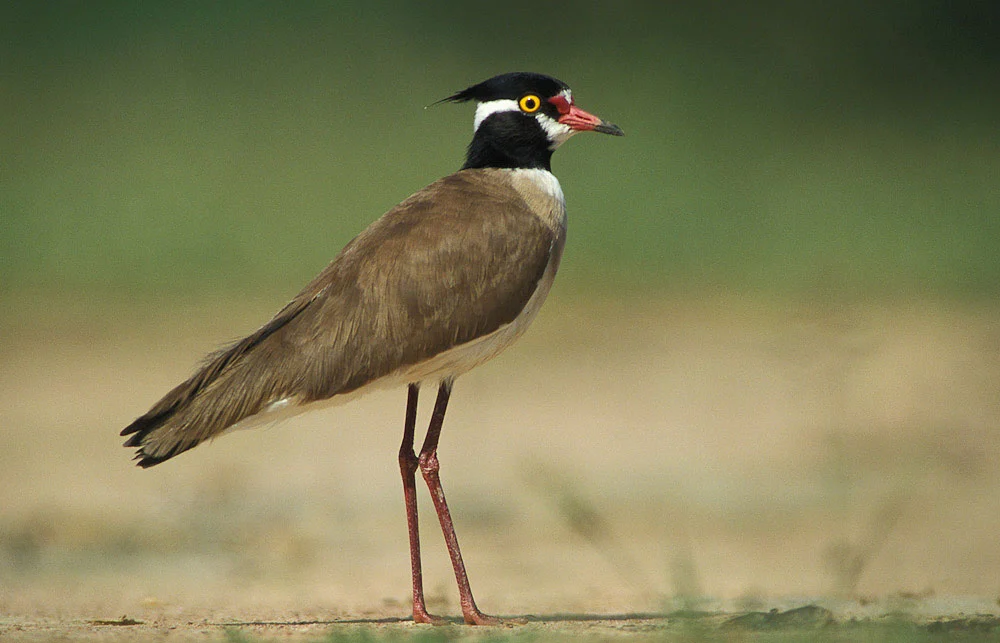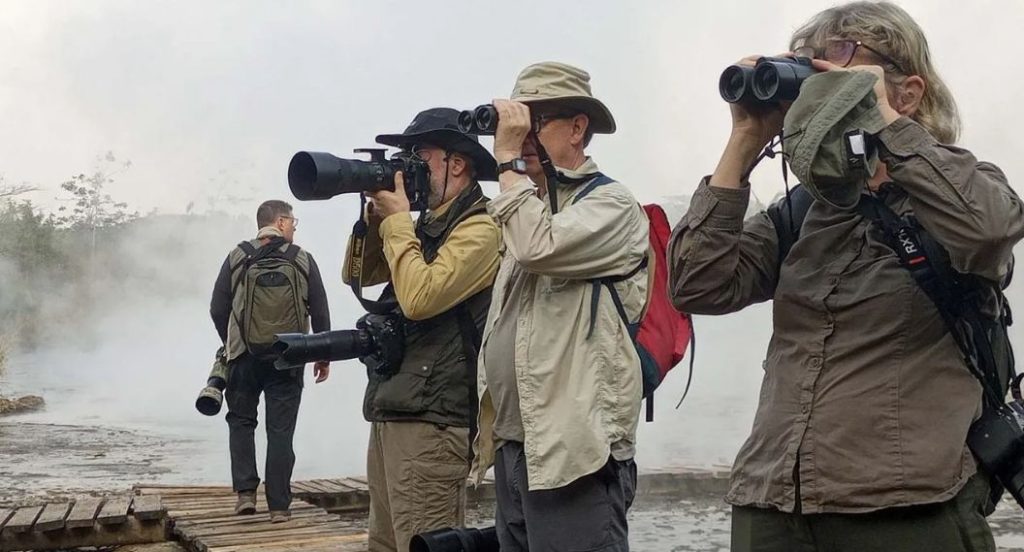Table of Contents
ToggleUganda is a diverse destination for wildlife viewing, and bird watching is no exception. With over 1100 bird species in Uganda, it ranks as the most attractive country in Africa to birders.
Uganda’s unique location between the savannah, rainforest, and semi-desert makes it a friendly home to various bird species. Many of Uganda’s bird species are found exclusively in the tropical forests, with some rare sightings being described as “mythical”.
It is also believed that some of the birds living in Uganda’s remote rain-forests may not even be classified as of yet! The simple guide below brings you to the most iconic birds of Uganda and the very best destinations for bird watching in Uganda.
What Are The most iconic birds of Uganda?
We have listed four bird species that you want want to look out during safari in Uganda. Their distinctive sizes, beaks, and plumage will make your Uganda trip even more unforgettable.

1. Shoebill
Laying your eyes on the shoebill will make you feel like you have entered a Jurassic Park. With its enormous bill and tall stature, this slate-grey bird looks like a small dinosaur.
Shoebills can reach over 1.2m in height, have a wingspan of up to 2.4m, and weigh up to 7kg. Their massive beak resembles a shoe (which explains the name).
The beak, tan with brown spots, measures 5 inches in width, and is equipped with sharp edges and a pointed hook at the end. This specialized beak enables the shoebill to capture large prey such as lungfish, monitor lizards, snakes, and baby crocodiles.
Hunting like total bosses of the swamp, the shoebill stands motionless like a statue, patiently waiting for the unfortunate lungfish or baby crocodile to swim by. The bird then thrust forward, all 2 meters of it, with its massive beak wide open, engulfing its target along with water, mud, and vegetation.
After securing its prey, the bird begins to shake its head back and forth to expel whatever stuff it doesn’t want to eat. When only the lungfish or crocodile is left, the shoebill swiftly decapitates with the sharp edges of its beak and swallows away. It is hard not to be impressed by this colossal bird.

2. Ugandan Crane (Grey-crowned Crane)
Once you see the crane, you will quickly understand why it has such a majestic name.
It stands around one meter and weighs about 3.5 kilograms. This long-legged bird has an elaborate mating ritual, which includes dancing, bowing, and jumping.
With its grey body, white wings accented with brown and gold feathers, white cheeks, vivid red sac, and striking crown of stiff feathers, the Grey-crowned crane is truly a remarkable sight. It also serves as the national symbol of Uganda and is depicted on the flag of Uganda.

3. Great Blue Turaco
The Great Blue Turaco is a beautiful bird, though its beauty comes with a downside. Sadly, it is currently actively hunted for its vibrant feathers and meat. You might spot their distinctive bills first – they are bright yellow with a red tip. The Turaco is not the best at flying because of its short, round wings; instead, you are more likely to see it gliding or leaping from tree to tree.

4. Saddle Billed Stork
True to its name, the Saddle-billed Stork features a large, striking bill with a red base, a black band, and a yellow frontal shield, resembling a ‘saddle.’
Its back, head, neck, wings, and tail are an iridescent black, while the rest of its body and primary flight feathers are white. Additionally, this wading bird is notable for its impressive height, standing nearly 5 feet tall, making it one of the tallest birds in the world.

Best Destinations For Bird Watching In Uganda
There are a variety of great spots for bird watching in Uganda.
If you need extra knowledge or help with spotting birds, there are plenty of birding tours to book inside the national parks of Uganda. It is advisable to indicate your birding interest beforehand, as expertise may vary among Uganda Wildlife Authority Rangers.
The lodges in the destinations mentioned below are also great starting points for bird watching. Their teams often include trained guides who are well-versed in local birdlife. Some Tulambule driver-guides also possess extensive birding knowledge.
If you have a particular interest in bird watching, let us know in advance, and we’ll do our best to match you with a suitable driver-guide.
1. Bwindi impenetrable Forest
Bwindi Impenetrable National Park is the heart and soul of bird watching in Uganda, renowned for its numerous endemic and rare bird species.
This park is home to approximately 350 bird species, including 23 species that are endemic to the Albertine Rift Valley. The national park is also home to nearly half of the world’s mountain gorilla population and a variety of colorful butterflies.

2. Kibale Forest
Kibale Forest hosts six Albertine Rift endemics and offers sightings of around 375 bird species across its wetlands, tropical forests, woodlands, and savannahs.
The community-run Bigodi Wetland Sanctuary is especially notable, featuring species such as the Great Blue Turaco, Papyrus Gonolek, White-winged Warbler, and Papyrus Canary.
Kibale Forest also has the greatest density and diversity of primates in Africa. More than a dozen primate species inhabit this vast rainforest, most visibly red-tailed monkey, red colobus, black-and-white colobus, and the endemic Uganda mangabey.
However, for most visitors, Kibale’s main primate attraction is a chimpanzee community that was habituated in the 1990s and is now incredibly relaxed around people.

3. Lake Victoria (and Mabamba Swamp)
Lake Victoria is the largest lake in Africa and the second-largest freshwater lake on Earth. The lake is home to around 300 bird species.
From Entebbe and the lake itself, travellers can easily reach Mabamba Swamp, where its papyrus-lined marshes offer excellent opportunities to spot shoebills.

4. Lake Mburo National Park
Lake Mburo National Park offers epic bird-watching opportunities at its lake swamps, Warukiri and Rwonyo. The park also features other habitats such as dry hillsides, rocky outcrops, and dense savannah. It is home to over 350 bird species, including papyrus gonolek, shoebills, Grey Crowned Crane, Bateleur, Rufous-bellied Heron, Black-bellied Bustard, Coqui Francolin, Saddle-billed stork, Brown-chested Lapwing, and the elusive African finfoot. Mburo is also home to over 68 mammal species including large herds of zebras, buffalos, and antelopes.

5. Queen Elizabeth National Park
Over 600 species of birds have been sighted and recorded in Queen Elizabeth National Park across various habitats – from savannah to dense forest, saline crater lakes, freshwater lakes, rivers, and papyrus swamps. The park is also home to over 95 mammal species including four of the Big 5 and tree-climbing lions. A must-visit if you’re around!

6. Murchison Falls National Park
Murchison Falls National Park boasts the world’s strongest waterfall, created when the mighty Nile River (the longest river on the planet) is squeezed through an 8-metre gap in the rocks. The park is home to over 450 bird species and 76 mammals, including 4 of the Big Five.
Bird watching here can be enjoyed on a boat cruise along the Nile or during a game drive. The park’s diverse habitats include riverine woodland, swamp, forest, palm savannah, and acacia-dotted plains. The top birds include sheobills, Grey-crowned cranes, double-toothed barbet, red-throated bee-eater, Puvel’s illadopsis, ground-hornbills, Secretary bird, and the strange-looking piapiac.

7. Kidepo National Park
Kidepo National Park is recognized by CNN Travel as one of Africa’s most beautiful national parks. Situated in the Karamoja region in northeastern Uganda, near the South Sudan border, it is perfect for those seeking a remote, adventurous and off-the-beaten-track experience.
The park’s varied landscape supports nearly 500 bird species and 77 mammal species. Bird watching is excellent throughout the year, with the prime time being from March to April when migratory and special birds are most visible.

8. Pian Upe Wildlife Reserve
Pian Upe Wildlife Reserve is Uganda’s largest wildlife reserve. The reserve is home to over 242 bird species, encompassing savannah birds, migratory species, and endemics.

Rare And Special Bird Watching In Uganda
For avid birdwatchers, the destinations listed below are likely to pique your interest, as they offer opportunities to see some of Uganda’s most elusive and rare bird species.
1. Semliki National Park
Semuliki National Park is East Africa’s sole true lowland tropical forest, providing a habitat for some very special species. Many birds here are highly localized, so you can expect to encounter species not found anywhere else.
Semliki National Park hosts over 444 bird species including African openbill, great white pelicans, malachite kingfishers, and a range of other unique birds. Additionally, migratory birds transit through from November to April, with the majority of local birds breeding in March.

2. Budongo Forest
Budongo is a top spot for forest bird watching in Uganda, with over 360 bird species currently known. The forest features the “Royal Mile”, a renowned birding trail.
Here, you can spot the Yellow-footed Flycatcher, Blue-breasted Kingfisher, Nahan’s Francolin, Black-eared Groundthrush, Pygmy Crake, Black-winged Pratincole, Brown Twinspot, Cassin’s Hawk Eagle, White-thighed Hornbill, Dwarf and Kingfisher among many others.
3. Mabira Forest
Mabira, which means “big forest” in the local Luganda language, is the largest natural forest in central Uganda and is home to around 315 bird species.
Although photographing birds can be challenging due to the forest conditions, a visit to Mabira promises exceptional bird watching opportunities.
best months for bird watching in Uganda
The best time for birdwatching in Uganda generally aligns with the dry season, which runs from December to February and from June to August.
During these months, the dry weather creates ideal conditions for birding, improving visibility and allowing for better observation of a wide range of bird species.
Additionally, the presence of many migratory birds during this time enhances the birdwatching experience. However, Uganda’s diverse bird population remains abundant and fascinating year-round, making bird watching enjoyable in any season.
Should I get a birding guide in Uganda?
You are certain to see more birds with a professional naturalist guide in Uganda.
These guides know bird calls, can often mimic them, and can detect unique birding behaviors that the untrained eye or ear would miss. Furthermore, they’ll often bring professional bincoluars along so you can get a closer look at the birds you come across than you otherwise would have.

Birding Safaris in Uganda – tailored itineraries
- 17 Days Uganda Birding Tour
- 5 Days Uganda Birding Tour
- 7 Days Uganda Birding Tour
- 1 Day Mabamba Swamp Birding Tour
We hope we inspired you to pack your bird field guide and binoculars! Looking for great itineraries to combine your birding with? Check out our Uganda safaris and start planning your birding safari now!
